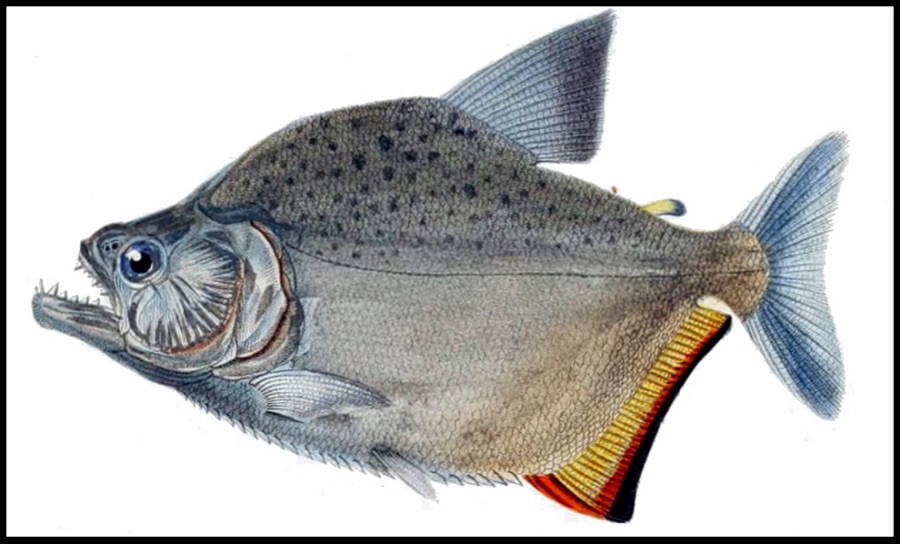Piranha
Piranha
South America's most notorious fish is plentiful in the Pantanal. Under the right conditions, they can live up to their voracious reputation - but entering the waters of the Pantanal doesn't necessarily mean you'll disappear in a tumult of thrashing waters.
Piranha
- Red-bellied piranha (Pygocentrus nattereri). This species is the most common species - and with the most fearsome reputation. Although named for their usually red belly, they can also appear orange or yellow. Some are so intensely gold-speckled that they are sometimes also called "Gold Dust piranha". They have a convex head-shape and sometimes red-coloured eyes.
- Ruby-red piranha or Gold piranha (Serrasalmus spilopleura aka. S. maculatus). Same size as the red-bellied. Can appear gold or yellowish, with black trim on their tail. Others of this species in the Amazon region have a bright orange-red underside. Slightly concave head-shape.
- Marginatus piranha or Pirambeba (Serrasalmus marginatus). Silver, with a yellow anal fin, tinged with black. Concave shaped head. This species has a preference for shady areas, hiding in vegetation close to the riverbanks. Adults measure up to 20 cm (8 in).
Behaviour and Habitat
Piranha hunt, but are opportunistic - targeting easy prey which appear old, weak, wounded or exhibiting signs of distress. Hence, the common triggers for attacks are splashing and the scent of blood. Strangely, the fact that piranha are prey for a multitude of other animals (e.g. dorado, jacaré, giant otters, amazon dolphins and numerous species of birds), makes piranhas timid - and is why they frequently stay together in shoals as a form of mutual protection.
The seasonal rise and fall of most waters where piranhas live is also directly and indirectly responsible for numerous piranha deaths. During the dry season many piranhas of all sizes become trapped in desiccating floodplain lakes and ponds cut off from the rivers. Most either die or become food items for predators and scavengers such as fish-eating mammals, wading birds, jacaré, water snakes and vultures.
Scientific Name
Pygocentrus nattereri

Local Name
Piranha

Description
Short robust fish measuring 14-33 cm (5-13 in) with a blunt, slightly convex or slightly concave head depending on species. Unmistakable very sharp triangular teeth. Generally silver in colour with an orange, yellow or black underbelly.
Piranha Attacks
The most dangerous period for attacks is usually the dry season. This is where the piranha are concentrated into smaller areas - and less food in the environment makes them more aggressive. This is less of an issue in major rivers where they are free to move further downstream - but lagoons and oxbow lakes can be especially dangerous.
Boi de Piranha
Reproduction
During this spawning season, piranhas become more aggressive towards other fish as they pair up and defend their spawning territories. Spawning typically occurs in lagoons or in shallow water close to riverbanks, where the female lays clusters of 1,000 to 5,000 eggs in a bowl-shaped nest formed in sediment close to vegetation. These nests are 4-5 cm (1.5-2 in) deep, and around 15 cm (6 in) in diameter. Individual eggs measure about 3mm (1/8 in) in size. The nest is subsequently fertilised by the male.
Eggs hatch after two to five days depending on water temperature and species, with both parents staying nearby to protect their eggs and subsequent brood. Based on observations in aquariums, it appears that males choose the nest site, then create the bowl-shaped depression - sometimes removing excess vegetation by biting it with their sharp teeth. Notably, spawning doesn’t always go smoothly since males initiate courtship by actively pursuing a female - but it can sometimes end up in the mutilation or death of one or both fish.
Drawing of Serrasalmus marginatus by Paul Louis Oudart, dated 1847. This shows the coloration and it’s concave (inward curving) head shape. Credit: Paul Louis Oudart
Notes for Fishing
- Be VERY careful removing them from your hook. Although your piranha bite scar might enthral listeners at a bar or pub in future as you recount and embellish your story - it really hurts, so probably isn’t worth it. Hold the fish firmly, behind the gills.
- Place a small length of leader wire above the hook. Don’t hang the hook directly on the fishing line as those sharp teeth will cut straight through the line (meaning you’ll lose both the hook and the fish).
Cooking Your Piranha
Conservation and Threats
Quick Facts
- Piranhas are the most common fish in the Pantanal. They occur in virtually all places where there is water with some depth.
- Although piranha attacks in Pantanal rivers are extremely rare, caution is advised. Do not swim in areas where you see a lot of them. Don’t let them circulate around swimmers or divers.
- A large 12 kg pintado catfish can be devoured by a school of piranhas in less than two minutes. Once the prey is in the process of being stripped, other local fish such as piraputangas will also join in for a meal.
- If swimming in rivers with piranhas, the breaststroke is recommended since this causes less noise and stirring in the water. In closed ponds and lagoons it is recommended not to swim at all.
- Piranha have been reported in the waters of Florida and Thailand after supposedly having been dumped by aquarium owners or traders. However there hasn’t yet been any acknowledgment of them becoming a serious invasive species or threat in either location.
- In his book Exploration Fawcett, Colonel Fawcett describes execution by piranha which supposedly took place during the Paraguayan War. Those to be executed were tied to stakes in the water - then cut, leaving the piranha to do the rest.
Banner image: Piranha with mouth open (Shutterstock/Alberto Loyo).

